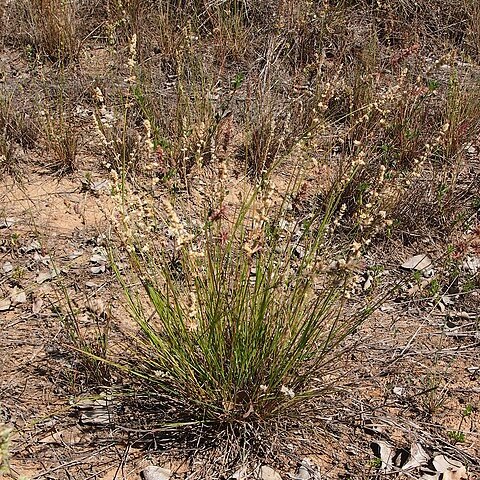Annuals or perennials, often glandular particularly on leaf-sheath and inflorescence. Leaf-blades linear; ligule usually reduced to a ciliate rim, rarely membranous. Inflorescence an open, contracted or spike-like panicle, the branches sometimes racemose but at least the longer with short side branchlets (except E. flavicans), rarely ending in a slender bristle. Spikelets laterally compressed, variously disarticulating, awnless (except 9, E. arisiiglumis); glumes mostly subequal, shorter than the lowest lemma and 1-nerved; lemmas 3-nerved, mostly glabrous, acuminate to emarginate, rarely mucronulate; palea a little shorter than the lemma, deciduous or persistent, the keels sometimes long-ciliate, rarely winged; anthers 2–3. Caryopsis usually globose to ellipsoid, smooth or finely striate to finely reticulate, the pericarp adherent (sometimes slightly loose but never free).
Spikelets 2–many-fld, slightly to strongly flattened, disarticulating above the glumes and between the lemmas, or eventually fragmenting irregularly, or the lemmas individually deciduous from the persistent rachilla (the grain falling free); glumes 1-veined or the second one 3-veined, usually unequal; lemma 3-veined (the lateral veins sometimes obscure), awnless, blunt to acute or short-acuminate, ± keeled but varying from V-shaped in cross-section to rounded on the back; palea somewhat shorter than the lemma, often ciliate on the 2 keels; grain short-cylindric to subglobose, ovoid, or pyriform; ligule a band of short hairs; sheaths almost always pilose or hirsute at the top; panicle open and ± diffusely branched, varying to dense and subglobose to cylindric or spike-like; only 2 of our spp. have anthers more than ca 0.5 mm. 250, cosmop.
Annual or perennial, often glandular particularly on the leaf sheaths and inflorescence. Leaf blades mostly flat, sometimes rolled, rarely pungent; ligule a line of hairs or sometimes membranous. Inflorescence an open, contracted, spiciform or glomerate panicle, very rarely of racemes on a central axis. Spikelets 2-to many-flowered, laterally compressed, orbicular to vermiform, variously disarticulating. Glumes unequal, deciduous or persistent, 1(–3)-veined. Lemmas membranous to coriaceous, keeled or rounded, glabrous to asperulous or rarely hairy, 3-veined or the veins sometimes very faint and occasionally suppressed, apex entire, obtuse to acuminate, rarely mucronate. Palea keels sometimes winged or ciliate. Stamens 2 or 3. Fruit mostly globose, ellipsoid, or rectangular-prismatic, usually a caryopsis but sometimes the pericarp free.
Spikelets 2–many-flowered (a few lower florets sterile in 22. E. plurigluma), orbicular to vermiform, variously disarticulating; glumes often deciduous, 1-or rarely 3-nerved; lemmas 3-nerved but the laterals sometimes very faint and occasionally suppressed, dorsally keeled or rounded, membranous to coriaceous, glabrous to asperulous or rarely hairy, entire or rarely 3-toothed or lobed, obtuse to acuminate, rarely mucronate or shortly awned, or with excurrent lateral nerves; palea keels sometimes winged or ciliate; anthers 2–3.Fruit mostly rotund to elliptic, usually a caryopsis but sometimes the pericarp free.
Spikelets few-to many-flowered, the rachilla disarticulating above the glumes and between the florets, or continuous, the lemmas deciduous, the paleas persistent; glumes acute or acuminate, 1-nerved, or the second rarely 3-nerved, much shorter than the spikelet; lemmas acute or acuminate, keeled or rounded on the back, 3-nerved, the nerves prominent or sometimes obscure; palea 2-nerved, often ciliate on the keels.
Inflorescence an open, contracted, spiciform or glomerate panicle, very rarely of racemes on a central axis.


